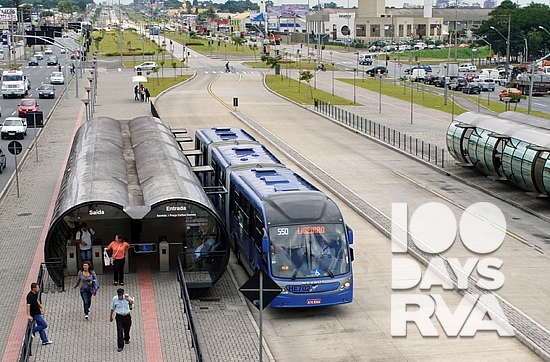Day #057: Keep BRT rapid
Plans can get watered down over the course of four years. Richmond can learn some lessons from failed BRT projects.

Inspired by Michael Bierut’s 100 Day Project, 100 Days to a Better RVA strives to introduce and investigate unique ideas to improving the city of Richmond. View the entire project here and the intro here.
- Idea: Don’t water down BRT plans, and make sure all dimensions are implemented before the grand-openeing.
- Difficulty: 1 — The city has the funding to build a world class system. Does it have the political will and fortitude?
Last Tuesday, Senator Mark Warner announced that the U.S. Department of Transportation has awarded Richmond $24.9 million for the development of a Bus Rapid Transit (BRT) line running from Willow Lawn to Rocketts Landing down Broad Street.
The grant will cover half of the $49.8 million dollar bill for the exciting 7.6 mile project. The rest will be funded by state and local funds.1 The announcement is one small step in the marathon of creating sustainable and equitable transportation in this city and it deserves to be celebrated, but now begins the difficult battle of keeping the BRT rapid.
Bus Rapid Transit aims to combine the affordability and flexibility of buses with the capacity and speed of rail. Real BRT has dedicated lanes, onboard signal priority systems, prominent busway alignment that avoids parking and loading, high capacity cars, platform-level boarding to expedite access, and protected stations.
Cleveland’s successful HealthLine is a model that Richmond is attempting to follow, but maybe even more can be learned from projects like Chicago’s CTA BRT. The project began with lofty expectations similar to Richmond’s, but opposition watered the project down to BRTINO (“BRT in name only”).
Chicago has limited its traffic signal priority to a 1.5 mile stretch–although the system installation was delayed. There are no bus-only lanes (half of Richmond’s is already planned to be “mixed traffic operations”). A key bypass lane was delayed near the entrance to a toll bridge.
The results were “a far cry” from Chicago’s initial plan and were gimmicky rebranded normal buses that eroded residents’ confidence that effective BRT was realizable.
Projects like Chicago are often excused with claims of incrementalism and smart growth, but they miss the point. A huge goal of BRT is attracting “choice riders.” When battling bus stigma and trying to attract riders with alternatives, you only get one first chance.
A lot can happen between now and the project’s anticipated opening in 2018. The city should avoid “being careful to implement BRT without imposing major negative impacts on car drivers” and favor building the best BRT system in the country. Drivers should look over and envy the affordable, passive, efficient BRT ride.
On Day #022, I wrote “If only GRTC were more like Chipotle.” This will especially ring true for BRT. Without obsessing over branding and the nuances of operation and customer experience, like a private company, GRTC could fail to find a meaningful return on $50 million worth of investment while eroding RVA’s confidence in buses and government.
Creating a name without the word bus, implementing an efficient payment system (Apple Pay, unlimited plans, and reloadable cards), and smart hours of operation may seem minor, but when the alternative is highly subsidized2 automobile travel, then it is the ball game. The difference between BRT and BRTINO is in the details, and those devilish details have plagued once-promising BRT plans across the country.
Love this idea? Think it’s terrible? Have one that’s ten times better? Head over to the 100 Days to a Better RVA Facebook page and join in the conversation.
Photo by: mariordo59
- Hopefully VCU can kick in funds by reducing their contract with Groome transportation which transports students from the Monroe Park to MCV–it’s probably the only standing room only bus in Richmond. ↩
- Why are roads called investment while buses are subsidized? Roads are not funded entirely by user-generated fees, and GRTC receives a fraction of government automobile funding. ↩
-
Recommend this
on Facebook -

Report an error
-

Subscribe to our
Weekly Digest





There are 2 reader comments. Read them.